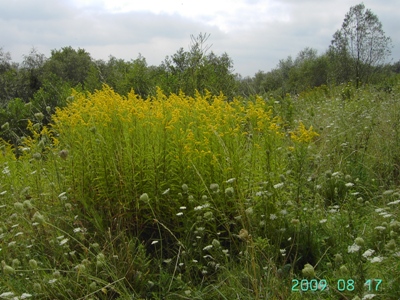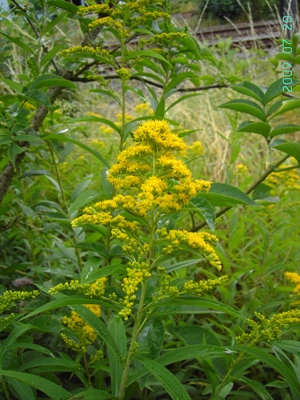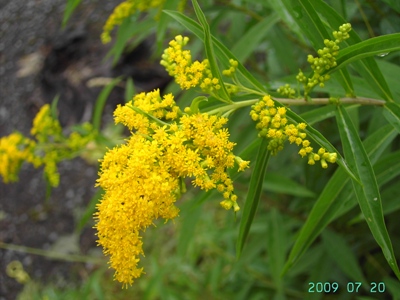Solidago gigantea
Solidago gigantea Ait. (syn.: S. serotina Ait., S. gigantea subsp. serotina (O. Kuntze) McNeill, S. gigantea var. serotina (O. Kuntze) Cronq.) (N-Am.) – A commonly naturalised and increasing escape from cultivation or garden throw-out. First recorded in 1869 at the fortifications of Dendermonde. Soon afterwards also collected in several different, widely scattered locations, for instance near Leuven and in the valley of river Meuse. It was already reported as abundantly naturalised in 1877 near Gelrode (railway track). However, all early records were erroneously ascribed to Solidago canadensis (Lawalrée & Vanden Berghen 1946).
Solidago gigantea is rather variable but less so than S. canadensis and S. altissima. It is in fact the least hairy species of the complex. Plants with leaves pubescent on the veins beneath, slightly smaller involucres (3,2-4 mm long) and glabrous achenes were formerly segregated as Solidago serotina. This species is currently treated as a mere synonym of Solidago gigantea (Semple & Cook 2006). In Belgium, although confused for quite some time, Solidago gigantea is easily distinguished from S. canadensis: it has glabrous (except inflorescence branches), often glaucous (or reddish) stems and leaves, larger heads with longer ligules, etc. There is also a remarkable phenological difference: despite its Dutch vernacular name (“Late guldenroede”) Solidago gigantea flowers earlier than S. canadensis (apparently not only in Europe but also in, at least parts of, North America; see Semple & Cook 2006).
Solidago gigantea often forms very dense, nearly monospecific stands in Belgium and is locally regarded as an invasive environmental weed. It often occupies the same man-made habitats like Solidago canadensis (road verges, railway tracks, wasteland, dumps,…) but much more regularly penetrates in nature-like habitats (especially riverbanks, grassland, etc.). Additional information on the invasion history of Solidago gigantea in Belgium and the Netherlands is available at: http://ias.biodiversity.be/species/show/17 and http://www.q-bank.eu/Plants/BioloMICS.aspx?Table=Plants%20-%20Species&Rec=1049&Fields=All.
 |
 |
 |
 |
Selected literature:
Adolphi K. (1995) Neophytische Kultur- und Anbaupflanzen als Kulturflüchtlinge des Rheinlandes. Nardus 2: 272 p.
Beaudry J.R. (1978) Etudes sur les Solidago L.: 12. Hybridation entre deux especes sympatriques, S. purshii et S. rugosa. Nat. Canad. 105(4): 285-290.
Güsewell S. (2005) Distribution and functional traits of Solidago gigantea in a Swiss lakeshore wetland. Botanica Helvetica 115: 63-75.
Guzikowa M. & Maycock P.F. (1986) The invasion and expansion of three North American species of goldenrod (Solidago canadensis L. sensu lato, S. gigantea Ait. and S. graminifolia (L.) Salisb.) in Poland. Acta Soc. Bot. Pol. 55(3): 367-384.
Jakobs G. (2001) Life-history and genetic variation of native vs. introduced populations of the perennial Solidago gigantea Ait. (Asteraceae). Bulletin of the Geobotanical Institute ETH 67: 73-78.
Lawalrée A. & Vanden Berghen C. (1946) Note sur quelques phanérogames de la flore belge. Bull. Soc. Roy. Bot. Belg. 78: 100-105.
Morton G.H. (1984) A practical treatment of the Solidago gigantea complex. Can. J. Bot. 62: 1279-1282.
Ottich I. (2005) Solidago canadensis und Solidago gigantea in Frankfurt am Main. Botanik und Naturschutz in Hessen 18: 55-66.
Schlaepfer D.R., Edwards P.J., Widmer A. & Billeter R. (2008) Phylogeography of native ploidy levels and invasive tetraploids of Solidago gigantea (Asteraceae). Molecular Ecology 17: 5245-5256.
Schlaepfer D.R., Edwards P.J., Semple J.C. & Billeter R. (2008) Cytogeography of Solidago gigantea (Asteraceae) and its invasive ploidy level. Journal of Biogeography 35: 2119-2127.
Schlaepfer D.R., Edwards P.J. & Billeter R. (2010) Why only tetraploid Solidago gigantea (Asteraceae) became invasive: a common garden comparison of ploidy levels. Ecologia 163: 661-673.
Semple J.C. & Cook R.E. (2006) Solidago. In: Flora of North America Editorial Committee (eds.), Flora of North America, vol. 20. Oxford University Press, New York-Oxford: 107-166.
Szabó L. (2000) A few characteristics of the life strategy of Solidago gigantea Ait. (germination ability of achene, fructans of the rhizome). Acta Agronomica Ováriensis 42: 51-59.
Verloove F. (2002) Ingeburgerde plantensoorten in Vlaanderen. Mededeling van het Instituut voor Natuurbehoud n° 20: 227 p.
Verloove F. (2006b) Solidago gigantea. In: Van Landuyt W., Hoste I., Vanhecke L., Van den Bremt P., Vercruysse W. & De Beer D., Atlas van de flora van Vlaanderen en het Brussels gewest. Instituut voor Natuur- en Bosonderzoek, Nationale Plantentuin van België en Flo.Wer: 840.
Voser-Huber M.L. (1983) Studien an eingebürgerten Arten der Gattung Solidago L. Probleme mit S. gigantea, S. canadensis und S. graminifolia in Naturschutzgebieten des Schweizerischen Mittellandes. Diss. Bot. 68: 1-157.
Walter E. (1987) Zur Verbreitung und zum Verhalten nordamerikanischer Goldruten (Solidago canadensis und S. gigantea) in Oberfranken. Ber. Naturforsch. Ges. Bamberg 62: 27-68.
Weber E. (1997b) Phenotypic variation of the introduced perennial Solidago gigantea in Europe. Nord. J. Bot. 17: 631-638.
Weber E. & Jakobs G. (2005) Biological flora of central Europe: Solidago gigantea Aiton. Flora 200: 109-118.
Wittig R. (1978) Zur pflanzensoziologischen und ökologischen Stellung ruderaler Bestände von Solidago canadensis L. und Solidago gigantea Ait. (Asteraceae) innerhalb der Klasse Artemisietea. Decheniana 131: 33-38.

